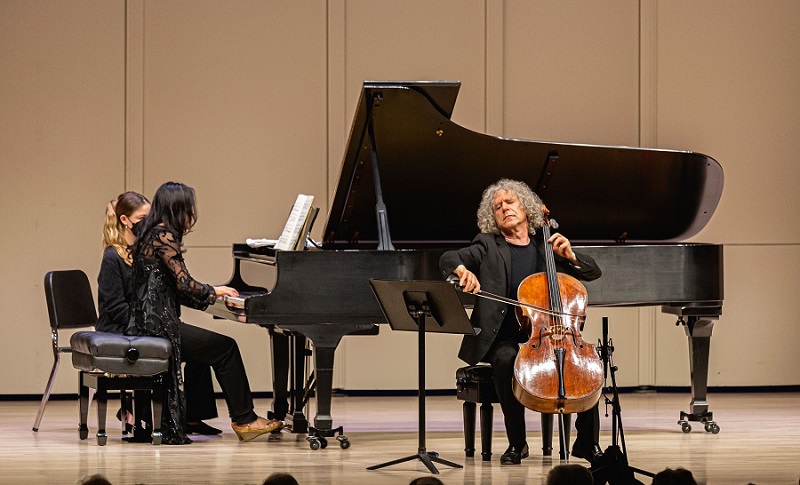Isserlis brings heart-melting tone to Shriver Hall program heavy on dessert

Cellist Steven Isserlis and pianist Connie Shih performed Sunday night at Shriver Hall. Photo: Arts Laureate
Steven Isserlis and Connie Shih gave a delectable recital Sunday evening at Shriver Hall. Their program, half-German and half-French, featured a couple of surprises along the way. Isserlis offered plenty of dulcet sound on the “Marquis de Corberon” Stradivarius cello he plays, built in 1726. The music was accompanied, as usual, by plenty of Isserlis’s seraphic smiles, flinging about of his silvery curls, and wry narration.
The British cellist and Canadian pianist opened with Reynaldo Hahn’s Variations chantantes sur un air ancien, recorded on their disc of music from the salons of Marcel Proust, released last year. Hahn’s sentimental piece, based on “Beato chi può,” an aria from
Cavalli’s Il Xerxe, is transgressively retrospective, baroque origins woven into a tapestry of languor. The duo’s flexible rubato allowed Isserlis to milk each longing phrase for maximum singing effect. A variation with florid cello trills brought Shih, often too reticent, briefly into the foreground.
Isserlis has made the septuagenarian Gabriel Fauré’s Cello Sonata No. 2 a signature piece, especially its music-box Andante. The piece owes its origins to that slow movement, composed first as the Chant funéraire, an official commission for the 100th anniversary of the death of Napoleon, held at his tomb in Les Invalides. This mournful, mysterious melody suited Isserlis’s strengths, as he spun out soft, long-breathed lines with his steady bow arm and sure sense of intonation.
The outer movements satisfied less, although Shih restrained herself to accommodate the gut strings Isserlis adores. In the first movement, Isserlis’s rolling melody flowed effortlessly, echoed almost imperceptibly by Shih over the deft, active accompaniment. When Shih could let loose, she did, creating booming climaxes in both first and third movements, the latter taken at an admirably swift tempo and driven to an ecstatic close.
Isserlis recorded this Fauré sonata a decade ago with pianist Thomas Adès, the composer of the work that followed it, Lieux retrouvés, recorded on the same disc. An evocation of four “places regained,” another obvious allusion to Proust and his Time Regained, the piece provided some acerbic delights. Isserlis floated the swirling introduction to the first movement (“Les eaux”), and as the music roiled more, Shih came out of her shell with stronger, more percussive sound. In the second movement (“La montagne”), Isserlis ascended the heights with strident pizzicato strikes, dissolving into wispy harmonics in the thin atmosphere of the summit.
In the third movement (“Les champs”), Isserlis’s poignant melody circled into higher and higher registers, ending up at “the highest notes I’ve ever had to play lyrically,” as the cellist once put it. This is a sort of obsession with Adès, whose operas The Tempest and The Exterminating Angel have both pushed singers to the upper edge of the human voice’s possibilities. In the finale, labeled “Cancan macabre” by the composer, Isserlis’s snide squeals on the cello punctuated an infernal dance, with aggressive glissandi and tremolos in the piano.
Isserlis’s other favorite composer, Robert Schumann, led off the second half, in an elegiac rendition of the Adagio and Allegro. Few cellists can match Isserlis’s tender leaning on the anguished appoggiaturas of the first movement, again given space and freedom of rhythm by Shih. In the fast-moving second movement, Isserlis unfurled the triplet passages with precision, but the climactic ascents to high notes work better on the French horn, for which Schumann first wrote the piece.
The program disappointed a bit in its conclusion, the Cello Sonata No. 2 of Brahms. It is music centered strongly on the piano, and Shih responded with more force where she could. Isserlis’s tone just needed to be beefier to stand up to the modern grand piano. The duo found a way to split the difference in the first movement, but the interpretation missed the mark in the slow movement, which came off more precious than burning.
Likewise the third movement, set at a very fast tempo, became a blur, with the constant stream of triple-grouped notes losing distinction in a somewhat muddy texture. The Finale also lacked solidity, turned towards affectation for some climactic moments. Although the applause was a little tepid, Isserlis returned eventually for an encore. He and Shih returned to their forte, music at a svelte and sensitive piano dynamic, with an arrangement of one of Chopin’s Polish Songs, Op. 74. The thirteenth song, “Nie ma czego trzeba” (Faded and vanished), sent the audience out into the rainy evening, as its words read, where “The rain is cold, and its roar is loud.”
Bass-baritone Davóne Tines and pianist Adam Nielsen perform songs by Shaw, Bach, Sorey, Eastman, and others 5:30 p.m. November 6. shriverconcerts.org

